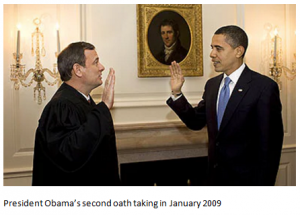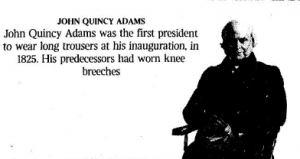U.S. Presidential Inaugurations: from Lincoln to Trump
As president elect, Donald Trump, makes his final preparations to become the 45th president of the United States at midday on Friday 20th January , a day that will surely go down in the history books, it seems fitting to look back at some other notable occurrences in the history of presidential inaugurations over the years using the libraries online reference tools: http://www.richmond.gov.uk/information_online.htm [Press articles are available through NewsBank and NewsVault via the preceding link]
History and Background
George Washington took the first oath of office on a balcony in the Federal Hall on Wall Street, New York City when he become president of the United States on the 30th April 1789. All subsequent regular inaugurations took place in March until 1933 when Inauguration Day was moved to January 20th.
The official ceremony consists of the incoming President taking the Oath of Office, giving the Inaugural Speech, reviewing the Inaugural Parade and then rounds off with various Inaugural Balls, or not.
Thomas Jefferson (1743-1826), the third president, was the first to be inaugurated in Washington, D.C. Not every subsequent ceremony has been held in Washington – presidents who assume office upon the death of their predecessor take the oath wherever they are at the time and do not celebrate public ‘inaugurations’ as such.
The Oath
The words spoken by the president are: “I do solemnly swear (or affirm) that I will faithfully execute the office of President of the United States, and will, to the best of my ability, preserve, protect and defend the Constitution of the United States.”
So help me God has been added onto the end by many an incoming president although these do not form part of the oath.
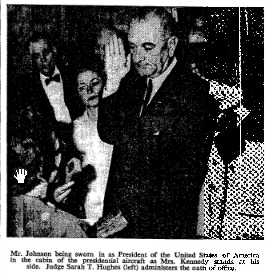
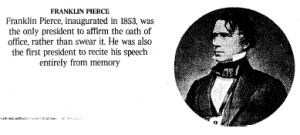

Most presidents have sworn (or affirmed) the oath on a bible; some exceptions being Theodore Roosevelt – who took office after the death of his predecessor – who used no book at all and John Quincy Adams and Franklin Pierce who swore on a book of law.
Barack Obama, in 2013, swore the oath on the Lincoln Bible and a bible belonging to Martin Luther King.
The bible is always opened on a passage and no two presidents have chosen the same one.
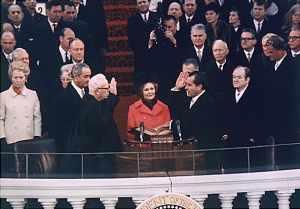
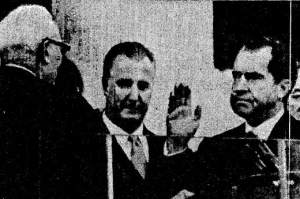
Richard Nixon takes the presidential oath on two bibles, both family heirlooms.
The oath taking ceremony is usually led by the Chief Justice of the United States; again there are a few exceptions, the most notable being Calvin Coolidge who, after learning of President Harding’s death on 3 August 1923, was sworn in as President by his father, the justice of the peace in Plymouth, Vermont. The one and only woman overseer of an inauguration was Sarah T. Hughes, a judge from Texas, who administered the oath to Lyndon B. Johnson on Air Force One after the assassination of John F. Kennedy in 1963. Johnson swore on JFK’s Catholic missal rather than a bible.
Since 1941 Inauguration Day has taken place on 20 January; if the 20th falls on a Sunday the oath is taken in private then repeated publicly the next day. Only two presidents have taken the oath four times: Franklin D. Roosevelt was the only US leader to have been elected four times and hence had four inauguration ceremonies. Barack Obama repeated the words that Chief Justice John Roberts mixed up during his first oath taking in 2009; the ceremony was repeated the following day in private and, when re-elected in 2013, 20 January fell on a Sunday, he had a private and a public ceremony.
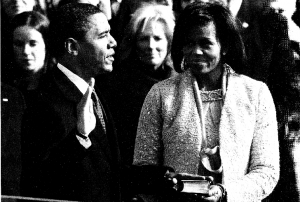
The Speech
George Washington gave a speech of only 135 words following his second inauguration in 1793, in contrast, the ninth president, William Henry Harrison, droned on for over two hours in the rain in 1841 (in contrast his speech was 8495 words). Unfortunately he caught pneumonia and died within a month. Some say the events are related!
Many parts of inaugural speeches have ended up in the Oxford Dictionary of Quotations, including JFK’s, ‘ask not what your country can do for you—ask what you can do for your country.’ and Franklin D. Roosevelt’s, ‘The only thing we have to fear is fear itself.’
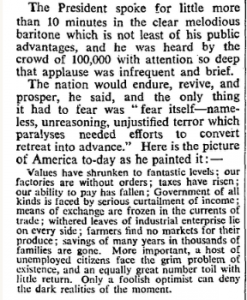
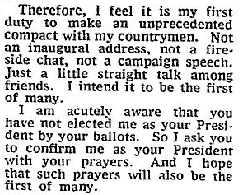
Gerald Ford, the first person to be vice-president and president without being elected to either office, stated that his inaugural address was, ‘Just a little straight talk among friends.’
The Parade
And now to when the fun starts!
The inaugural parade which proceeds along Pennsylvania Avenue in front of the White House is usually reviewed by the President, the Vice-President and their respective families. The tradition was started by Thomas Jefferson after his second inauguration in 1805 when he, on horseback, was accompanied from the Capitol to the White House by shipmen from the Washington Navy Yard and musicians. Dwight Eisenhower’s first inauguration parade in 1953 was the most elaborate to date, including elephants and circus performers in the parade.
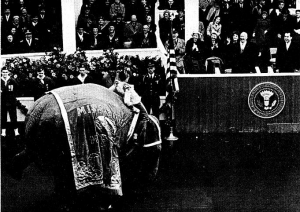
African-Americans were not included in the parade until 1865 (Abraham Lincoln’s second), women until 1917 (Woodrow Wilson’s second) and reserved places for disabled viewers not made available until Jimmy Carter walked in the parade in 1977 – the first president to do so. He managed to whittle down the costs of the inauguration to a mere $3.5 million (in contrast Clinton’s cost $33 million) by downgrading the inauguration ball to the status of a party, and serving peanuts (what else!) and pretzels!
The Balls (or parties as Carter would say)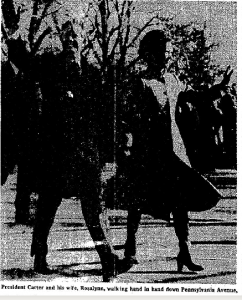
The inaugural ball is usually a series of invite-only events held on the night of the Presidential Inauguration in the Washington DC area. Tickets are pre-paid and the presidential team makes appearances at all of them. Andrew Jackson’s event turned into a free for all when gatecrashers poured into the White House, drank all the punch, caused ladies to scream and were only enticed out when servants took barrels of bourbon out into the White House grounds.
It was so cold on the second inauguration of Ulysses S. Grant in 1873 that guests had to dance in their coats and frozen birds reportedly fell into the punch bowl.
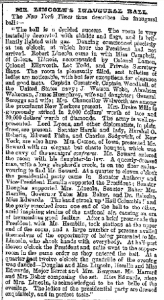
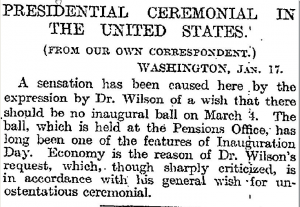
All in all, presidential inauguration days over the centuries have given the press much to gossip and something to talk about. And surely the events of 20 January 2017 will be no different.
[Sarah Dennison, Information & Reference Library Supervisor]

